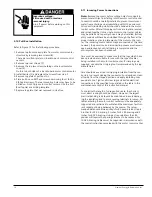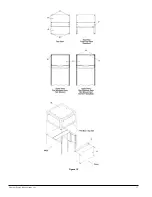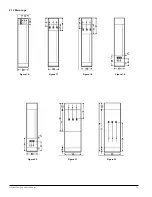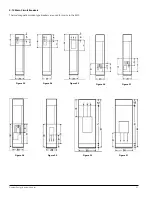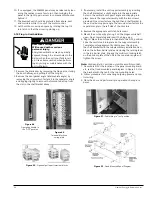
17. Verify that all ground connections have been properly
made. The sections of the motor control center which
were shipped separately must be connected in such a way
to assure a continuous grounding path.
18. Install covers, install units, close and secure doors, make
certain that no wires are pinched and that all enclosure
parts are properly aligned and secured.
19. Make sure the door interlocks on all disconnect operators
are properly adjusted and secured. If adjustment is
required, use the procedure explained in the Maintenance
section of this instruction manual.
20. Disconnect any safety grounds which have been connected
to the power bus.
21. Check all connections for mechanical and electrical tight-
ness.
4.2 Energizing Equipment
Hazardous Voltage.
Failure to check this equipment
prior to energization can cause
death or serious personal injury.
All pre-energized checks outlined in
this instruction manual must be per-
formed before the equipment is
energized by Qualified Personnel
only.
1. In order to minimize risk of injury or damage, or both, there
should be no load on the motor control center when it is
energized. Turn off all of the downstream leads, including
those such as distribution equipment and other devices
which are remote from the motor control center.
2. The equipment should be energized in sequence by starting
at the source end of the system and working towards the
load end. In other words, energize the main devices, then
the feeder devices, and then the branch-circuit devices.
With barriers (if applicable) in place, and unit doors closed
and latched, turn the devices on with a firm positive
motion. Protective devices that are not quick-acting should
not be “teased” into the closed position.
3. After all disconnect devices have been closed, loads such as
lighting circuits, starters, contactors, heaters, and motors,
may be turned on to verify that the system operates as
intended.
4.3 Permissible Loading of Motor Control Centers
1. For motor control centers without main overcurrent protec-
tive devices, the total continuous load current through the
horizontal bus should not exceed the current rating of the
motor control center.
2. For motor control centers with a single main overcurrent
protective device, the total continuous load current on the
protective device should not exceed 80 percent of its
ampere rating unless the device is rated to carry 100 per-
cent of its ampere rating, in an enclosure.
3. For motor control centers with multiple main overcurrent
protective devices, the total continuous current through the
horizontal bus should not exceed the current rating of the
motor control center. The total continuous load current on
each overcurrent protective device should not exceed 80
percent of its ampere rating unless the device is rated to
carry 100 percent of its ampere rating, in an enclosure.
4. For branch-circuit overcurrent protective devices in a motor
control center, the total continuous load current on the pro-
tective device should not exceed 80 percent of its ampere
rating unless the device is rated to carry 100 percent of its
ampere rating, in an enclosure.
5. Unless a current limiting means is used in a series combina-
tion, the maximum short-circuit current rating of the entire
motor control center is the smallest of the following:
a. the rating of the bus structure, or
b. the lowest rating of the motor control units, or
c. the lowest rating of the feeder units.
This motor control center rating is clearly indicated on the
lead sheet located in the information packet.
Siemens Energy & Automation, Inc.
30

